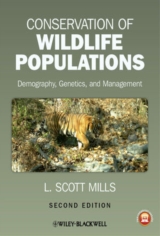|
Population ecology has matured to a sophisticated science with astonishing potential for contributing solutions to wildlife conservation and management challenges. And yet, much of the applied power of wildlife population ecology remains untapped because its broad sweep across disparate subfields has been isolated in specialized texts. In this book, L. Scott Mills covers the full spectrum of applied wildlife population ecology, including genomic tools for non-invasive genetic sampling, predation, population projections, climate change and invasive species, harvest modeling, viability analysis, focal species concepts, and analyses of connectivity in fragmented landscapes. With a readable style, analytical rigor, and hundreds of examples drawn from around the world, Conservation of Wildlife Populations (2nd ed) provides the conceptual basis for applying population ecology to wildlife conservation decision-making. Although targeting primarily undergraduates and beginning graduate students with some basic training in basic ecology and statistics (in majors that could include wildlife biology, conservation biology, ecology, environmental studies, and biology), the book will also be useful for practitioners in the field who want to find - in one place and with plenty of applied examples - the latest advances in the genetic and demographic aspects of population ecology.
contents
List of boxes, ix
Preface to second edition, xi
Preface to first edition, xii
List of symbols, xiv
Acknowledgments for second edition, xv
Acknowledgments for fi rst edition, xvi
PART I BACKGROUND TO APPLIED POPULATION BIOLOGY, 1
1 The big picture: human population dynamics meet applied population biology, 3
Introduction, 3
Population Ecology of Humans, 4
Extinction Rates of Other Species, 8
Humans and Sustainable Harvest, 12
The Big Picture, 13
2 Designing studies and interpreting population biology data: how do we know what we know?, 14
Introduction, 14
Obtaining Reliable Facts Through Sampling, 15
Linking Observed Facts to Ideasmind Leads to Understanding, 19
Ethics and the Wildlife Population Biologist, 29
3 Genetic concepts and tools to support wildlife population biology, 33
Introduction, 33
What Is Genetic Variation?, 33
Genetic Markers Used in Wildlife Population Biology, 35
Insights into Wildlife Population Biology Using Genetic Tools, 43
4 Estimating population vital rates, 54
Introduction, 54
Estimating Abundance and Density, 54
Survival Estimation, 67
Estimation of Reproduction, 70
Sex Ratio, 71
PART II POPULATION PROCESSES: THE BASIS FOR MANAGEMENT, 77
5 The simplest way to describe and project population growth: exponential or geometric change, 79
Introduction, 79
Fundamentals of Geometric or Exponential Growth, 80
Causes and Consequences of Variation in Population Growth, 84
Quantifying Exponential Population Growth in a Stochastic Environment, 91
6 All stage classes are not equal in their effects on population growth: structured population-projection models, 98
Introduction, 98
Anatomy of a Population-Projection Matrix, 99
How Timing of Sampling Affects the Matrix, 100
Projecting a Matrix Through Time Leads to Transient and Asymptotic Dynamics, 103
All Vital Rates are not Created Equal: Analytical Sensitivities and Elasticities, 108
Stochasticity in Age and Stage-Structured Populations, 109
Sensitivity Analysis in the Broad Sense to Help Evaluate Management Actions, 113
Fitness is Lambda, Selection is Management, 116
Case Studies Using Matrix Models to Guide Conservation Decision-Making, 118
7 Density-dependent population change, 126
Introduction, 126
Negative Density Dependence, 126
The Logistic: One Simple Model of Negative Density-Dependent Population Growth, 128
Some Counterintuitive Dynamics: Limit Cycles and Chaos, 133
Positive Density Dependence, 135
Negative and Positive Density Dependence Operate Together, 138
Component Versus Demographic Outcomes of Density Dependence, 140
8 Predation and wildlife populations, 142
Introduction, 142
Does Predation Affect Prey Numbers?, 143
Factor 1. Determining How Predation Affects Prey Numbers: Predation Rate, 145
Factor 2. Determining How Predation Affects Prey Numbers: Compensation, 150
Factor 3. Determining How Predation Affects Prey Numbers: Who Gets Killed, 152
9 Genetic variation and fi tness in wildlife populations, 154
Introduction, 154
Long-Term Benefi ts of Genetic Variation, 154
What Determines Levels of Genetic Variation in Populations?, 155
Quantifying the Loss of Heterozygosity: The Inbreeding Coefficient, 161
When Does Inbreeding Due to Genetic Drift Lead to Inbreeding Depression?, 162
Outbreeding Depression and the Loss of Local Adaptation, 165
Genetic Rescue, Genetic Restoration, and Long-Term Population Recovery, 167
Appropriate Levels of Genetic Connectivity, 168
Case Studies Where Genetic Rescue Meets the Real World, 169
10 Dynamics of multiple populations, 175
Introduction, 175
What Is Connectivity?, 176
Consequences of Connectivity for Wildlife Populations, 177
Measuring Connectivity Among Wildlife Populations, 177
Multiple Populations are not All Equal, 185
Options for Restoring Connectivity, 194
PART III APPLYING KNOWLEDGE OF POPULATION PROCESSES TO PROBLEMS OF DECLINING, SMALL, OR HARVESTABLE POPULATIONS, 199
11 Human-caused stressors: deterministic factors affecting populations, 201
Introduction, 201
General Effects of Deterministic Stressors on Populations: Adapt, Move, or Die, 201
Habitat Loss and Fragmentation, 203
Introduced and Invasive Species, 206
Pollution, 212
Overharvest, 214
Global Climate Change, 215
Multiple Deterministic Stressors Occur Simultaneously, 220
12 Predicting the dynamics of small and declining populations, 224
Introduction, 224
Ecological Characteristics Predicting
Risk, 224
The Extinction Vortex, 226
Predicting Risks in Small Populations, 226
Population Viability Analysis (PVA): Quantitative Methods of Assessing Viability, 227
Other Approaches to Assessing Viability, 239
13 Focal species to bridge from populations to ecosystems, 244
Introduction, 244
The Four Categories of Focal Species, 245
Summary, 249
Further Reading, 250
14 Population biology to guide sustainable harvest, 251
Introduction, 251
Effects of Hunting on Population Dynamics, 252
Long-Term Effects: Hunting as an Evolutionary Force, 257
Models to Guide Sustainable Harvest, 258
Waterfowl Harvest and Adaptive Harvest Management in the US, 264
Management of Overabundant and Pest Populations, 265
Summary, 266
Further Reading, 267
Epilogue, 269
References, 271
Index, 301
Colour Plates fall between page 160 and 161
|





















